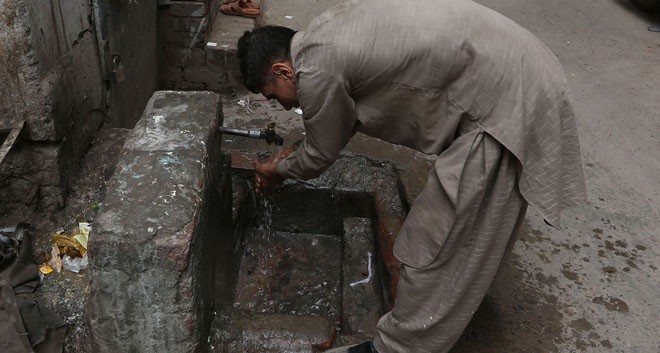

Seventy percent of drinking water available to Lahorites is contaminated, according to Pakistan Council of Research in Water Resources (PCRWR). This is the water that is coming from taps conveyed through old, galvanised pipes.
"All we need is to change the pipes that carry water from the source to the taps," says environmentalist and civil engineer Tariq Latif of Punjab Urban Resource Centre. "This can be done through ultra poly vinyl chloride (UPVC) pipes which are easy to join by heating, in a manner that no joint remains. When there will be no joint, there will be no leakage.
"They can also bear the highest pressure," he adds.
Water and Sanitation Agency (WASA) officials are also clear on this. They have approved high density poly ethylene (HDPE) pipes to replace asbestos cement (AC) pipes whose joints are weak and develop hairline cracks if hit. They have been replaced by other pipes throughout the world. Wasa intends to change the pipes but no cut-off date has been given for that so far.
If, at all, the old pipes are replaced by new and better pipes, will that solve the problem? The perplexing issue is the presence of arsenic in water.
What is more worrying is that the people still don’t know the arsenic level in water in different areas of the city. In 2004, Wasa announced that there is arsenic in drinking water in the city. Wasa must issue the table of arsenic level in water. It is hard to digest Wasa’s excuse that the survey is yet to be completed -- even a decade later.
Public must not be kept in the dark. It is taking its toll on their health. It is the responsibility of the government to inform and educate people.
In 2004, Pakistan Council of Research in Water Resources, on the basis of a study conducted in 21 cities of the country, found arsenic and fluoride beyond safe limits in water in several cities of the Punjab including Lahore.
By now, Wasa has installed water filtration plants for arsenic removal on 93 tube wells in the city and says the worst quality is water is to be found in Shahdara.
Wasa plans to install arsenic removal plants on another 100 tube wells this year, at the cost of Rs280-290 million. A senior Wasa official tells TNS, on condition of anonymity, that out of the 484 tube wells installed in the city, water in 184 is unfit for drinking.
"Provision of clean drinking water would require an extra spending of Rs4 to 5 billion," says the Wasa official.
On the other hand, the water table in the city is going down fast. Water level in the city is like a bowl which is deepest at Shah Jamal at present. Ten years ago, the water level was deepest at Shimla Pahari. Wasa is presently drawing drinking water from as deep as 800 feet at places.
Water is a natural resource. What will man do if, God forbid, water becomes scarce? That’s a million-dollar question. The answer lies in conservation and saving, but how?
As per the Wasa official, making rain harvesting system in every house -- as it has been done in New Delhi -- is the solution.
To provide clean drinking water to people, he recommends development of water resources and addressing the quality of water which would certainly improve if asbestos cement pipes are replaced with HDPE pipes, sharing reports on water quality with public, establishing water and trunk system, conducting surveys of consumer rights every two years, treating dirty sewerage water being dumped in the river Ravi and the canal at Harbanspura and involving people in making and running the system.
For all this, Wasa needs a professional board of directors -- "people who are technically sound," he insists.
Since the water level is going down fast and it being a natural resource, there is an urgent need to take measures to protect and save drinking water. People have been talking about laying two pipelines -- one that draws water from deep down the earth for drinking and another that draws surface water for other usages such as washing, cleaning and watering.
The idea now seems to have been accepted by the Punjab government which has decided to emulate Istanbul’s model where they have dual water pipelines.
It would be a great step to save water for the future generations. This said, the presence of arsenic remains a pressing issue. "This problem is not manmade," the Wasa official continues. "Arsenic is there in mother earth and gets mixed in water wherever it is there in water’s way."
But arsenic is bad. It damages the liver and causes health problems. People have the right to know its level in water in the different areas of the city. Wasa must not withhold this information from public. The filtration plants in place and those being installed notwithstanding, the public has the right to know the arsenic level in water that they are taking so that they can prevent any harm to their health. They will arrange for the right water once they know the water they are taking is not clean. But please, do not keep them in the dark.